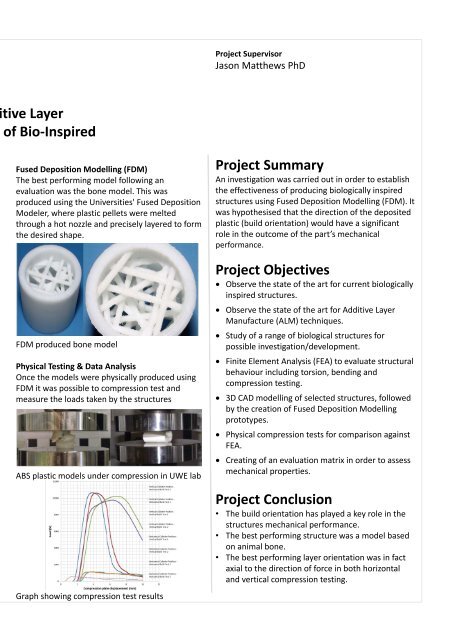UWE Bristol Engineering showcase 2015
Create successful ePaper yourself
Turn your PDF publications into a flip-book with our unique Google optimized e-Paper software.
Dom Dececio<br />
Mechanical <strong>Engineering</strong> (MEng)<br />
Project Supervisor<br />
Jason Matthews PhD<br />
Background Research<br />
A variety of previous research studies were<br />
reviewed covering both Additive Layer<br />
Manufacture (ALM) and Bio-Inspired structures.<br />
The biological structures included bamboo, bone,<br />
honeycomb, nautilus shell and spider’s web<br />
Computer Aided Design (CAD)<br />
Ideas were generated following a background<br />
literature review. This resulted in the creation of<br />
CAD models replicating the associated biological<br />
structures.<br />
Bamboo CAD model<br />
Understanding the process limitations of the Additive Layer<br />
Manufacture Process to support the optimisation of Bio-Inspired<br />
structures<br />
Finite Element Analysis (FEA)<br />
FEA was carried out on all of the CAD models to<br />
identify the strongest models under specific<br />
loading conditions.<br />
Bone CAD model under curved face compression<br />
Fused Deposition Modelling (FDM)<br />
The best performing model following an<br />
evaluation was the bone model. This was<br />
produced using the Universities' Fused Deposition<br />
Modeler, where plastic pellets were melted<br />
through a hot nozzle and precisely layered to form<br />
the desired shape.<br />
FDM produced bone model<br />
Physical Testing & Data Analysis<br />
Once the models were physically produced using<br />
FDM it was possible to compression test and<br />
measure the loads taken by the structures<br />
ABS plastic models under compression in <strong>UWE</strong> lab<br />
Project Summary<br />
An investigation was carried out in order to establish<br />
the effectiveness of producing biologically inspired<br />
structures using Fused Deposition Modelling (FDM). It<br />
was hypothesised that the direction of the deposited<br />
plastic (build orientation) would have a significant<br />
role in the outcome of the part’s mechanical<br />
performance.<br />
Project Objectives<br />
• Observe the state of the art for current biologically<br />
inspired structures.<br />
• Observe the state of the art for Additive Layer<br />
Manufacture (ALM) techniques.<br />
• Study of a range of biological structures for<br />
possible investigation/development.<br />
• Finite Element Analysis (FEA) to evaluate structural<br />
behaviour including torsion, bending and<br />
compression testing.<br />
• 3D CAD modelling of selected structures, followed<br />
by the creation of Fused Deposition Modelling<br />
prototypes.<br />
• Physical compression tests for comparison against<br />
FEA.<br />
• Creating of an evaluation matrix in order to assess<br />
mechanical properties.<br />
Project Conclusion<br />
• The build orientation has played a key role in the<br />
structures mechanical performance.<br />
• The best performing structure was a model based<br />
on animal bone.<br />
• The best performing layer orientation was in fact<br />
axial to the direction of force in both horizontal<br />
and vertical compression testing.<br />
Nautilus shell model<br />
Iso clipping view showing higher stress regions<br />
Graph showing compression test results


